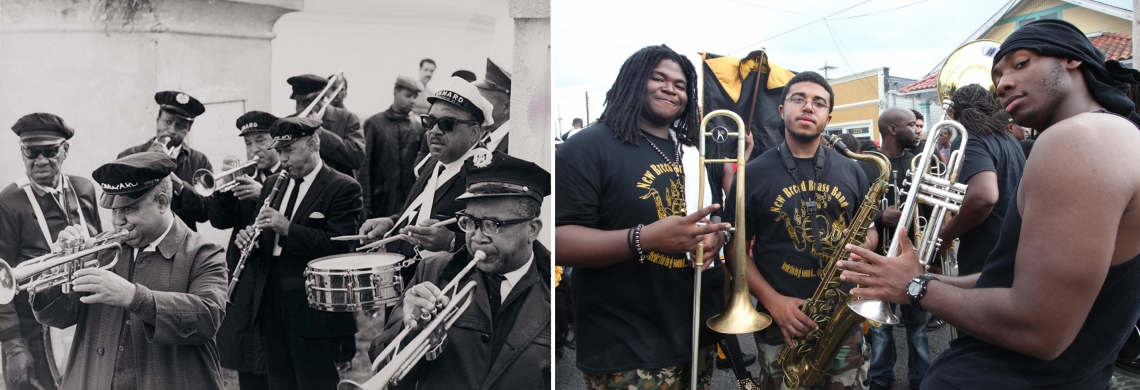Brass bands have powered neighborhood street parades for New Orleans social aid and pleasure clubs for more than a century, combining African and Afro-Caribbean rhythms with instruments of European origin–and, more recently, infusing the processions with rhythm and blues, funk, soul, and hip-hop.
The very recent history of Sunday-afternoon second line parades, though, has been mostly silence. The COVID-19 pandemic stilled the 2020–21 season, and Hurricane Ida scrambled the start of the new season, which typically runs from late August through early June. The Young Men Olympian Jr. Benevolent Association, formed in the 1880s, will officially christen second line parading’s return on Sunday, September 26. Two or three brass bands will provide the musical accompaniment (down from the club’s usual six), said YMO President Norman Dixon Jr. The “coming out” kickoff is scheduled for 1 p.m. at YMO’s headquarters at 2101 S. Liberty.
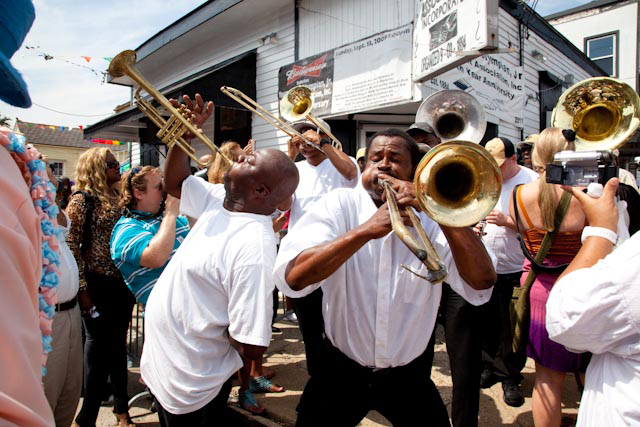
A brass band accompanies the Young Men Olympian Jr. parade, 2011. (Photograph by Leslie Parr)
“It’s important to the club, to the club members, to try to get back to normalcy,” Dixon said. “We’re going to be in masks, so it’s a way of dealing with what might be [the new] normal. There’s excitement in seeing how that’s going to turn out, excitement in bringing people together you haven’t seen in a long time, getting the community active again.
“We’ve got a lot of people sitting at home just waiting to do something, and this is one of the best ways, from way back in history, to express your emotions and celebrate life.”
Way back in history
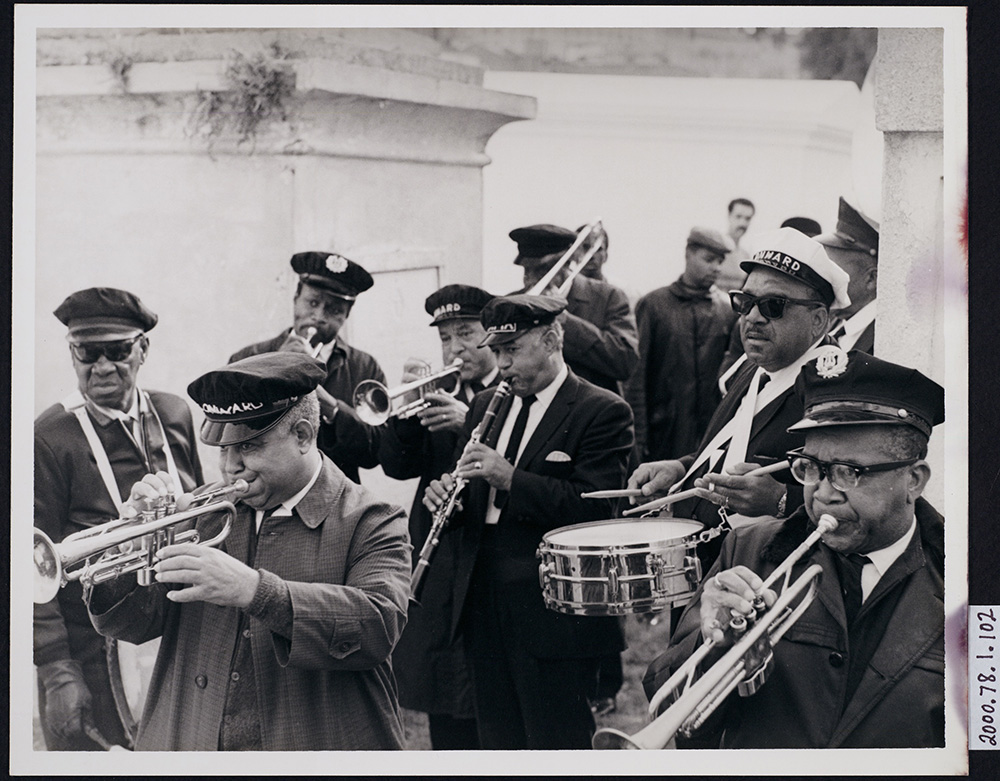
The Onward Brass Band parades in a cemetery in 1970. (Photograph by Jules Cahn, THNOC, 2000.78.1.102)
The Historic New Orleans Collection exhibition Dancing in the Streets: Social Aid and Pleasure Clubs of New Orleans, which was on view from February to June 2021, celebrated second line parades from their 19th-century origins through the last pre-pandemic parading season, 2019–20. On some days, when Visitor Services Assistant Douane Waples was on duty in the galleries, the exhibition grew an extra dimension for a few lucky visitors.
A saxophone player and composer for the Kings of Brass band, Waples has provided musical accompaniment for countless second line parades.
“I don’t like to lead with the whole musician thing,” Waples said. “If it comes up, it comes up. People are usually pretty surprised.”
Beyond his work in the galleries, Waples also shared his expertise in “Following the Beat on the Street,” a series of videos produced with fellow Visitor Services Assistant Dhani Adomaitis that tracked the four defining eras of local brass band evolution. Those videos, which supported the exhibition and its accompanying book of the same title, led up to the 2021 Bill Russell Lecture (sponsored by The Derbes Foundation), for which Waples and Adomaitis were joined by clarinetist and music scholar Dr. Michael G. White of Xavier University. The Kings of Brass perform “Fool’s Gambit,” a Waples composition, at 47:30 of the archived lecture.
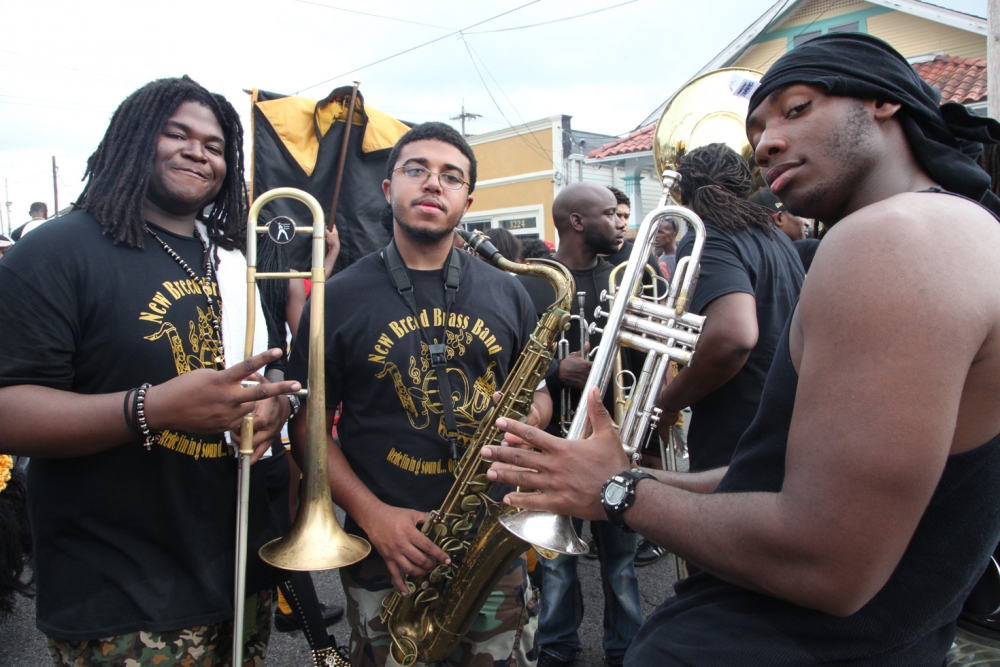
New Breed Brass Band trombonist Caleb Windsay, saxophonist Douane Waples, and trumpeter John Perkins in 2013. (photograph by Judy Cooper)
And there is Waples again, on page 156 of the exhibition’s accompanying book (and above, center, holding the saxophone). In the photo, by Judy Cooper, Waples is pictured with New Breed Brass Band trombonist Caleb Windsay and trumpeter John Perkins. The photo captures the men at a 2013 second line parade when Waples was making his way through his own musical evolution, which began in the marching band at McDonogh 35 High School, moved on to the New Orleans Center for Creative Arts and the University of New Orleans, the Baby Boyz Brass Band, the New Breed Brass Band, and now Kings of Brass.
In an essay in the Dancing in the Streets book, White notes that the New Breed Brass Band focuses “on adding a stronger popular-music feel to the prevailing funk style. Like many newer groups, the New Breed is visible in community parades as well as onstage.”
Waples’s New Breed chapter was elevated by an affiliation with New Orleans music icon Troy “Trombone Shorty” Andrews (uncle to New Breed snare drummer Jenard Andrews). Waples toured widely with the band, performing at the renowned Ascona (Switzerland) Jazz Festival.
The streets-and-stage approach has continued with the Kings of Brass, Waples said.
“I’ve heard this specific thing said consistently amongst everyone I talk to,” he said. “They hear us and they’re like, ‘Y’all are not for the streets. Y’all need to be hitting the stage, taking what y’all are playing around the nation and around the world.’ Some people think that our sound and the way we carry ourselves is on a larger scale and could be appreciated on a much larger scale than just doing these second lines. That’s not necessarily how we see ourselves because . . . we have a lot of guys in the band that try to put emphasis on making something that speaks to the streets, so we’ve been trying to balance that for a long time.”
The Beat on the Street
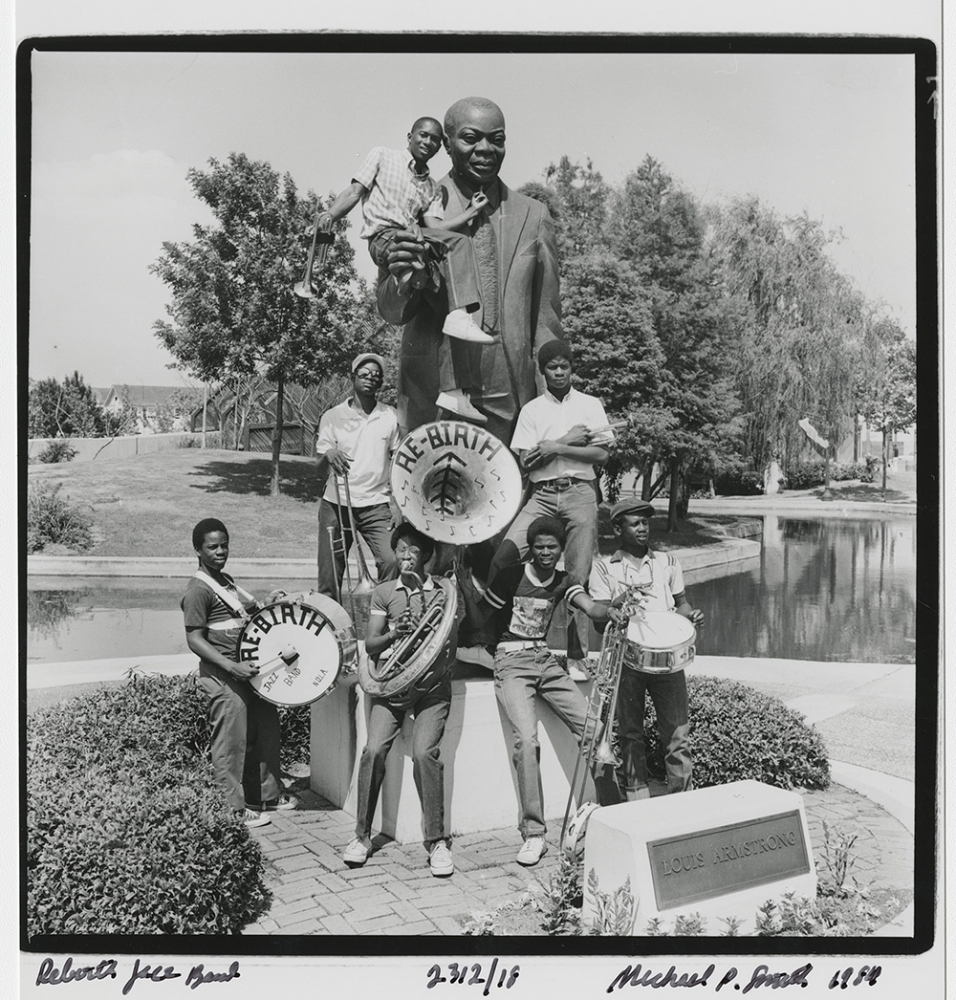
The Rebirth Brass Band is shown here in 1984. “Though heavily influenced by the (Dirty) Dozen, the Rebirth . . . created a more laid-back, funky style that eventually added influences from the emerging genre of hip-hop,” writes Dr. Michael White. (photograph by Michael P. Smith ©THNOC, 2007.0103.4.351)
In her essay about second line dance styles in Dancing in the Streets, Rachel Carrico describes the parades as a “four-hour, forward-moving dance party.” Brass bands provide the propulsion, starting with the “coming out the door” ritual that launches each procession. “One by one, each man, woman, and child dramatically steps through the door of someone’s house or neighborhood establishment, revealing him- or herself to the awaiting public,” Carrico writes.
“Usually, sometimes more often than not, that’s the time the type of music you play is a bit more orchestrated, something specific they might want to come out to,” Waples said. “For me, the excitement comes in based on the confidence and excitement the person coming out is showing. If they give me good energy, then I try to give it back.”
And then comes the parade, where energy becomes an issue—at least for the musicians supplying the soundtrack.
“There’s definitely some adrenaline involved,” Waples said. “There’s not enough adrenaline in the human body that can get you past that New Orleans climate. The heat and humidity can be pretty tough.
“The moment we stop, man, it’s . . .
“I could (play a parade) every Sunday in the season. I don’t think that I would want to, though. At the start of the parade everyone is full of energy. By the end, everyone is pretty tired. It becomes increasingly difficult to play at the same intensity as the parade goes on.”
Returning to the streets
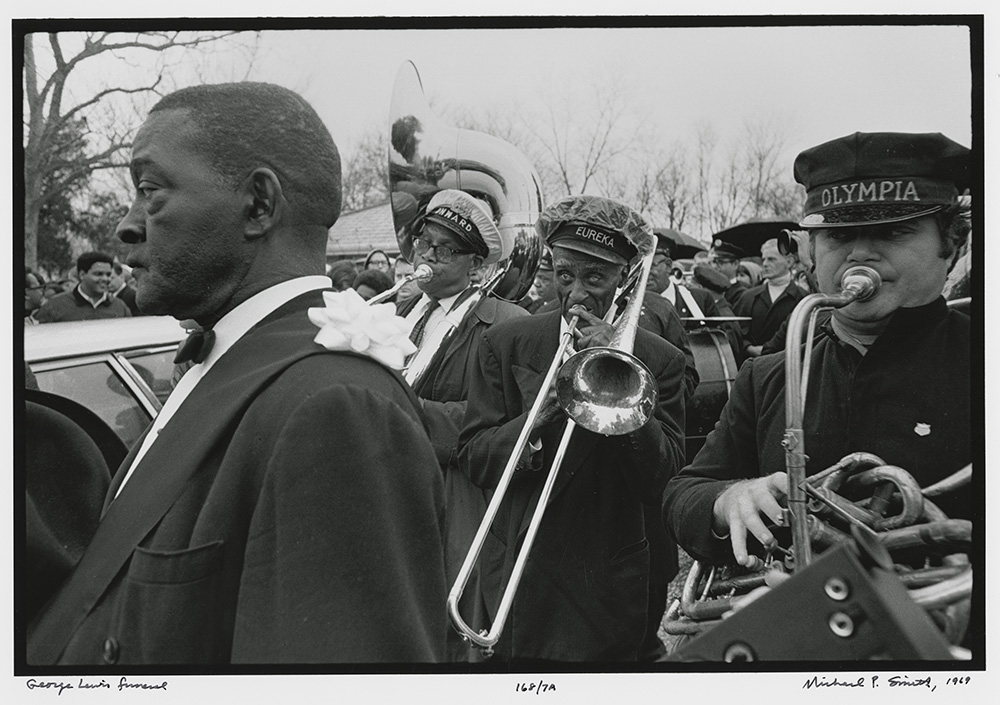
Members of various brass bands, including Eureka, Olympia and Onward, perform during the jazz funeral for clarinetist George Lewis in 1969. (photograph by Michael P. Smith ©THNOC, 2007.0103.2.156)
Organizing a social aid and pleasure club parade is “a lot of work,” Waples said. “It’s something I can totally respect. It speaks to a continuation of peaceful protests in the city, Black people claiming space. These people parading through their neighborhood are claiming space in a city where they historically weren’t allowed to join in parading events.
“It’s also very expensive. These guys, they get that money together. People tend to think of that as wasting money. I think about it like this: Everybody has something they invest their money and time into. This is that for them.”
Waples said he looks forward to a return to form for the second line community.
“I believe that they will come back in full swing,” he said. “I’m interested to see what changes will be made due to the fact they’ve had whole year to ruminate on what will happen. I think when the season opens up, people will go extra over-the-top or really try to push the envelope. I think it will be similar to the revival of the culture after Katrina.”
Dixon, with deep personal and professional connections to the clubs and brass bands, understands the symbiotic relationship between club members and the musicians who provide the beat on the street.
“The relationships are so special because everybody is usually from the same neighborhood,” Dixon said. “It’s not like we’re just meeting them. We likely grew up with them and played in high school bands with them.”
For the first time in too long, Dixon’s Young Men Olympian and the brass bands accompanying their neighborhood parade will bring the tradition back to life in three dimensions. Observers can expect joy and some pain—Dixon noted that many club members will dedicate their Sunday to family and friends lost during the pandemic—as well as finery and footwork making up the “forward-moving dance party” driven by the irresistible beat of New Orleans brass bands.
“The music makes you do what you do,” Dixon said. “There ain’t no wrong way.”
Visitor Services Assistant Dhani Adomaitis and Marketing Associate Eli. A. Haddow contributed to this story.

